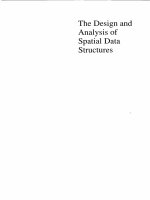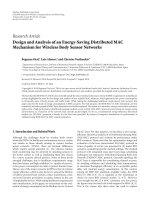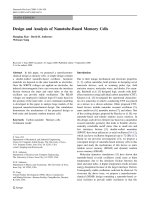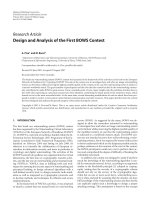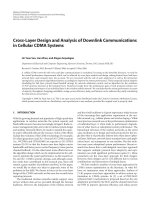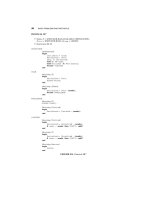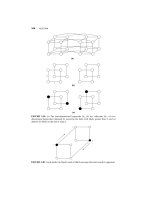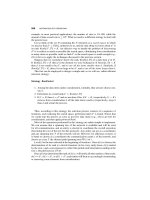Design and analysis of parity check code based optical recording systems
Bạn đang xem bản rút gọn của tài liệu. Xem và tải ngay bản đầy đủ của tài liệu tại đây (1.05 MB, 246 trang )
DESIGN AND ANALYSIS OF
PARITY-CHECK-CODE-BASED
OPTICAL RECORDING SYSTEMS
CAI KUI
NATIONAL UNIVERSITY OF SINGAPORE
2006
DESIGN AND ANALYSIS OF
PARITY-CHECK-CODE-BASED
OPTICAL RECORDING SYSTEMS
CAI KUI
(M. Eng., National University of Singapore)
A THESIS SUBMITTED
FOR THE DEGREE OF DOCTOR OF PHILOSOPHY IN ENGINEERING
DEPARTMENT OF ELECTRICAL AND COMPUTER ENGINEERING
NATIONAL UNIVERSITY OF SINGAPORE
2006
i
Acknowledgments
I would like to express my greatest gratitude to my supervisors, Prof. Jan W.
M. Bergmans and Asst. Prof. George Mathew, for their invaluable guidance,
constant and tremendous help and encouragement along my way to my Ph.D.
Without their help, this thesis would not exist in its current form.
I wish to express my heartfelt thanks to Prof. Jan W. M. Bergmans from
Technical University of Eindhoven, The Netherlands. It has been a great honor
and privilege to work under his supervision. I owe a lot to him for his high quality
supervision and enthusiastic and continuous help for my Ph.D. He has spent much
time in reviewing my work, providing advice and giving directions, and refining
my writing. I have gained tremendous wisdom from his constructive criticism
and invaluable advice, and enlightening discussions with him. I would like to
express my special thanks to him for arranging my visit to Technical University of
Eindhoven in 2003, and facilitating the valuable meetings and discussions with key
experts in Philips Research Laboratories, The Netherlands. I am truly grateful
to him.
I am deeply indebted to Asst. Prof. George Mathew from National University
of Singapore. He dedicated large amounts of his time and expertise in painstak-
0. Acknowledgments
ii
ingly teaching me, reviewing my work, providing critical reviews and comments,
and pointing out challenging problems and directions during every step of my
Ph.D. work. It would have simply been impossible to finish this work without
his tremendous help and supervision. His systematic and rigorous approach to
research has been a constant source of challenge to achieve greater heights, and it
will have a long-lasting effect on my career in the future. His guidance and help
for both my Ph.D. and my life will never be forgotten.
I would also like to express my sincere appreciation to Prof. Kees A. Schouhamer
Immink. He has freely shared his time and insights with me and provided precious advice to this work. The knowledge I gained from him was of great help
in my Ph.D. work. I am deeply grateful to him for the tremendous source of
knowledge and inspiration that he has given to me.
I am grateful to Dr. Victor Y. Krachkovsky, Agere Systems, Allentown, USA,
who was one of my supervisors during the initial period, for his involvement and
contributions in the initial stage of my research.
I would like to thank Prof. Frans Willems, Technical University of Eindhoven, and Dr. Wim M. J. Coene, Dr. Alexander Padiy, Dr. Stan Baggen, and
Dr. Bin Yin, all of Philips Research Laboratories, The Netherlands. They shared
with me a lot of valuable opinions and suggestions for my research.
I would like to thank Mr. Foo Yong Ning, National University of Singapore,
for his support in Sections 6.2.1 and 6.2.2 of the thesis. I am thankful to my
colleagues at the Data Storage Institute, Dr. Qin Zhiliang, Mr. Ye Weichun, Dr.
Chan Kheong Sann, Mr. Li Qing, Dr. Lin Yu, Mr. Zou Xiaoxin, and Mr. Peh
0. Acknowledgments
iii
Chester, who have helped me in one way or another.
Last but by no means least, I wish to thank my parents, my husband and my
daughter, for their unfailing love, encouragement, support, patience and sacrifice.
I dedicate this thesis to them.
iv
Contents
Acknowledgments
i
Contents
iv
Summary
ix
List of Abbreviations
xii
List of Symbols
xiv
List of Figures
xvi
List of Tables
xxi
Chapter 1. Introduction
1
1.1
Optical Recording Technology . . . . . . . . . . . . . . . . . . . .
1
1.2
Coding and Detection for Optical Recording . . . . . . . . . . . .
3
1.2.1
Optical Recording Systems . . . . . . . . . . . . . . . . . .
3
1.2.2
Imperfections in Optical Recording Channels . . . . . . . .
8
1.2.3
Overview of Coding and Detection Techniques . . . . . . .
11
1.2.4
Performance Measures . . . . . . . . . . . . . . . . . . . .
17
1.3
Motivation and Scope of the Current Work . . . . . . . . . . . . .
18
1.4
Contributions of the Thesis . . . . . . . . . . . . . . . . . . . . .
21
1.5
Organization of the Thesis . . . . . . . . . . . . . . . . . . . . . .
22
Chapter 2. Channel Model
2.1
Conventional Braat-Hopkins Model . . . . . . . . . . . . . . . . .
23
24
Contents
v
2.2
Generalized Model for Channel with White Noise . . . . . . . . .
29
2.3
Generalized Model for Channel with Media Noise . . . . . . . . .
33
2.3.1
Media Noise in Rewritable Optical Recording Systems . .
33
2.3.2
Channel Modeling for Media Noise . . . . . . . . . . . . .
34
2.4
Model Summary and Numerical Results . . . . . . . . . . . . . .
39
2.5
Conclusion . . . . . . . . . . . . . . . . . . . . . . . . . . . . . . .
41
Chapter 3. Parity-Check Coded Channels Based on Rate 2/3 Code 43
3.1
3.2
3.3
3.4
3.5
Bit Error Rate Analysis . . . . . . . . . . . . . . . . . . . . . . .
45
3.1.1
Introduction . . . . . . . . . . . . . . . . . . . . . . . . . .
45
3.1.2
Performance Bounds . . . . . . . . . . . . . . . . . . . . .
47
3.1.3
Comparison of Numerical and Simulation Results, without
Parity-Check (PC) Codes . . . . . . . . . . . . . . . . . .
54
Parity-Check Codes . . . . . . . . . . . . . . . . . . . . . . . . . .
58
3.2.1
Cyclic Redundancy Check (CRC) Codes . . . . . . . . . .
58
3.2.2
A New Single-Bit Parity-Check (PC) Code . . . . . . . . .
60
3.2.3
Hierarchical Scheme for Parity-Check (PC) Coding . . . .
60
Post-Processing Schemes . . . . . . . . . . . . . . . . . . . . . . .
62
3.3.1
Analysis of Parity-Check (PC) based Post-Processing . . .
62
3.3.2
Multiple-Error-Event Correction Post-Processor . . . . . .
65
Study of Boundary Error Events . . . . . . . . . . . . . . . . . . .
68
3.4.1
Boundary Error Event Analysis . . . . . . . . . . . . . . .
69
3.4.2
A Novel Remedy Scheme . . . . . . . . . . . . . . . . . . .
70
BER Performance and Discussion . . . . . . . . . . . . . . . . . .
72
3.5.1
Choice of Codeword Length . . . . . . . . . . . . . . . . .
72
3.5.2
Comparison of Theoretical BER Bounds with Simulations,
3.5.3
with Parity-Check (PC) Codes . . . . . . . . . . . . . . . .
76
Simulation Results . . . . . . . . . . . . . . . . . . . . . .
77
Contents
vi
3.6
81
Conclusion . . . . . . . . . . . . . . . . . . . . . . . . . . . . . . .
Chapter 4. Capacity-Approaching d = 1 Codes
4.1
83
Introduction . . . . . . . . . . . . . . . . . . . . . . . . . . . . . .
84
4.1.1
Constrained Codes for Blue Laser Disc Systems . . . . . .
84
4.1.2
Constrained Code Design Techniques . . . . . . . . . . . .
87
4.1.3
Motivation for the Current Work . . . . . . . . . . . . . .
90
4.2
Design of Capacity-Approaching d = 1 Codes
. . . . . . . . . . .
91
4.3
Optimum Number of Encoder States . . . . . . . . . . . . . . . .
93
4.3.1
Fibonacci and Generalized Fibonacci Numbers . . . . . . .
93
4.3.2
Relationship Between Encoder States and Code Size
94
4.3.3
Minimum Number of Encoder States . . . . . . . . . . . . 100
4.4
. . .
Conclusion . . . . . . . . . . . . . . . . . . . . . . . . . . . . . . . 111
Chapter 5. Capacity-Approaching Constrained Parity-Check Codes112
5.1
Introduction . . . . . . . . . . . . . . . . . . . . . . . . . . . . . . 114
5.2
General Principle of the New Code Design . . . . . . . . . . . . . 116
5.3
Code Design in NRZI Format . . . . . . . . . . . . . . . . . . . . 119
5.3.1
Encoder Description . . . . . . . . . . . . . . . . . . . . . 119
5.3.2
Design of the Component Codes . . . . . . . . . . . . . . . 121
5.3.3
Decoder Description . . . . . . . . . . . . . . . . . . . . . 124
5.4
Code Design in NRZ Format . . . . . . . . . . . . . . . . . . . . . 124
5.5
Examples of New Codes . . . . . . . . . . . . . . . . . . . . . . . 127
5.6
Performance Evaluation . . . . . . . . . . . . . . . . . . . . . . . 133
5.7
Conclusions . . . . . . . . . . . . . . . . . . . . . . . . . . . . . . 136
Chapter 6. Parity-Check Coded Channels with Media Noise
137
6.1
Introduction . . . . . . . . . . . . . . . . . . . . . . . . . . . . . . 138
6.2
Detection for Media Noise Channels . . . . . . . . . . . . . . . . . 140
6.2.1
Monic Constrained MMSE Equalization . . . . . . . . . . 140
Contents
6.2.2
vii
Viterbi Detection with Data-Dependent Noise
Variance . . . . . . . . . . . . . . . . . . . . . . . . . . . . 143
6.2.3
6.3
6.4
BER Simulation Results . . . . . . . . . . . . . . . . . . . 146
PC Codes and Post-processing for Media Noise Channels . . . . . 147
6.3.1
Parity-Check Codes . . . . . . . . . . . . . . . . . . . . . . 149
6.3.2
Data-Dependent Post-Processing . . . . . . . . . . . . . . 150
6.3.3
BER Simulation Results . . . . . . . . . . . . . . . . . . . 152
Conclusion . . . . . . . . . . . . . . . . . . . . . . . . . . . . . . . 155
Chapter 7. Performance Analysis with Error Correction Code
156
7.1
Introduction . . . . . . . . . . . . . . . . . . . . . . . . . . . . . . 157
7.2
Byte Error Rate of PC Coded Systems . . . . . . . . . . . . . . . 160
7.3
Semi-Analytical Approaches for Analyzing EFR . . . . . . . . . . 162
7.3.1
Multinomial Model . . . . . . . . . . . . . . . . . . . . . . 162
7.3.2
Block Multinomial Model . . . . . . . . . . . . . . . . . . 164
7.3.3
Accuracy Analysis for Non-Interleaved ECC . . . . . . . . 164
7.3.4
Generalized Multinomial/Block Multinomial
Methods . . . . . . . . . . . . . . . . . . . . . . . . . . . . 168
7.3.5
7.4
7.5
Accuracy Analysis for Interleaved ECC . . . . . . . . . . . 169
ECC Failure Rate of PC Coded Systems . . . . . . . . . . . . . . 173
7.4.1
Failure Rate With Non-Interleaved ECC . . . . . . . . . . 173
7.4.2
Failure Rate With Interleaved ECC . . . . . . . . . . . . . 175
Conclusion . . . . . . . . . . . . . . . . . . . . . . . . . . . . . . . 186
Chapter 8. Epilogue
188
8.1
Conclusions . . . . . . . . . . . . . . . . . . . . . . . . . . . . . . 188
8.2
Suggestions for Future Work . . . . . . . . . . . . . . . . . . . . . 195
Appendix A. Simplification of the MAP Post-Processor
197
Contents
viii
Appendix B. Criteria for Designing PRC Codes with d = 2 Constraint
199
Appendix C. Interleaving
202
Appendix D. Publications Originated from This Thesis
205
D.1 List of Papers . . . . . . . . . . . . . . . . . . . . . . . . . . . . . 205
D.2 List of Patents
Bibliography
. . . . . . . . . . . . . . . . . . . . . . . . . . . . 207
209
ix
Summary
The increasing demand for high-density and high-speed digital optical recording
systems has made the development of advanced coding and signal processing techniques for fast and reliable data recovery increasingly important. In recent years,
the parity-check (PC)-code-based reception technique has been widely studied
for magnetic recording systems, and it is projected to be highly promising for
high-density optical recording. The PC code is an inner error correction code
(ECC), which can detect dominant short error events of the system, using only
a few parity bits. This reduces the loss in error correction capability of the outer
ECC due to random short errors and results in a simple and efficient solution
to improve the overall performance. This thesis is dedicated to the design and
analysis of PC-code-based recording systems to achieve higher recording capacity
with low implementation complexity, for high-density blue laser disc systems. In
particular, most of the key components of the PC-code-based optical recording
system have been designed and optimized for different recording densities, and
different proportions of white noise and media noise.
During the development of advanced coding and detection techniques, it becomes necessary to investigate the system’s performance with different coding
schemes and recording densities. In Chapter 2 of the thesis, we propose a gener-
Summary
x
alized Braat-Hopkins model for optical recording channels, which provides a fair
basis for the performance comparison of detection schemes over different coding
schemes and recording densities, for channels with additive, white Gaussian noise
(AWGN) and media noise.
Various basic issues associated with the PC-code-based systems are investigated in Chapter 3. These include bounds for bit error rates and error event
probabilities, the dominant error events at channel detector output, different PC
codes, simple and efficient post-processors, the impact of error events that are
split across data block boundaries and the corresponding remedy, as well as the
effects of code rates and recording densities. Simulation results show that a 4-bit
PC code achieves the best performance. The corresponding bit error rates (BERs)
are very close to the performance bounds, at both nominal and high densities.
Constrained codes, which serve as a key component in the read-write channel
of data storage systems, are desired to have a high code rate with low-complexity
encoder/decoder. In Chapter 4, we investigate the design of certain capacityapproaching constrained codes for optical recording systems. In particular, we
derive analytically the relationship between the number of encoder states and
the maximum size of these codes. We identify the minimum number of encoder
states that maximizes the code rate, for any desired codeword length.
The design of constrained PC codes is key to the development of PC-codebased systems, and the systematic design of efficient constrained PC codes remains a challenging problem. In Chapter 5, we propose a general and systematic code design technique for constructing capacity-approaching constrained PC
Summary
xi
codes, which can detect any type of error events of the system, with the minimum
code rate loss. Compared to the rate 2/3 code without parity, the newly designed
constrained 4-bit PC code achieves a performance gain of 2 dB at nominal density,
and 1.5 dB at high density, at BER = 10−5 .
As the dominant noise for high-density optical recording systems, media
noise severely degrades the performance of channel detectors and post-processors
that are designed for AWGN. In Chapter 6, we propose two novel modifications
to the bit detector to combat media noise. We further develop a data-dependent
post-processing scheme for error correction. Compared to the system designed
without considering media noise and without PC codes, the overall performance
gain of the developed scheme can be more than 11 dB at high media noise levels.
In data storage systems, the ECC failure rate (EFR) serves as the ultimate measure of the data recovery performance. In Chapter 7, we develop semianalytical approaches for estimating the EFR, and analyze EFRs for the developed PC-code-based systems, for the cases without and with interleaving. Our
analysis shows that with the optimum interleaving degrees, compared to the rate
9/13 code without parity, the 2-bit PC code achieves a gain of around 0.5 dB,
and the 4-bit PC code gains 0.6 dB, at high recording density and EFR = 10−16 .
The thesis concludes in Chapter 8 with some suggestions for further work.
xii
List of Abbreviations
ACH:
AWGN:
BD:
BER:
BIS:
ByER:
CD:
CIRC:
DVD:
ECC:
EFM:
EFR:
ETM:
FS:
FSM:
GB:
GFS:
GS:
HD-DVD:
HDD:
ISI:
KB:
LDC:
MAP:
MB:
ML:
MLSD:
Adler-Coppersmith-Hassner
Additive White Gaussian Noise
Blu-ray Disc
Bit Error Rate
Burst Indicator Subcode
Byte Error Rate
Compact Disc
Cross-Interleaved Reed-Solomn Code
Digital Versatile Disc
Error Correction Code
Eight-to-Fourteen Modulation
ECC Failure Rate
Eight-to-Twelve Modulation
Fibonacci Sequence
Finite-State Machine
Giga-Bytes
Generalized Fibonacci Sequence
Guided Scrambling
High-Definition Digital Versatile Disc
Hard Disk Drive
Inter-Symbol Interference
Kilo-Bytes
Long Distance Code
Maximum a Posteriori
Mega-Bytes
Maximum Likelihood
Maximum Likelihood Sequence Detector
List of Abbreviations
MMSE:
MSE:
MTR:
NA:
NC:
NRZ:
NRZI:
PC:
PR:
PRC:
PRML:
RMTR:
ROM:
RS:
RW:
SBS:
SNR:
VD:
Minimum Mean Squared Error
Mean Squared Error
Maximum Transition Run
Numerical Aperture
Normal Constrained
Non-Return to Zero
Non-Return to Zero Inverse
Parity-Check
Partial Response
Parity-Related Constrained
Partial Response Maximum Likelihood
Repeated Minimum Transition Runlength
Read-Only Media
Reed-Solomn
Rewritable Media
Symbol-by-Symbol
Signal-to-Noise Ratio
Viterbi Detector
xiii
xiv
List of Symbols
ak :
a
ˆk :
ck :
CR :
Cpc :
dk :
ek :
e:
f (t):
fk :
fc :
gk :
h(t):
hk :
k:
Lg :
nk :
Npc :
p:
Pf :
PIf :
Pevent :
Pber :
Pber c :
Q(x):
qk :
r(t):
constrained coded bits, with ak ∈ {−1, +1}
estimate of ak
PR target output
capacity of constrained code
capacity of constrained PC code
channel input data pattern
total noise at channel detector input
error event
continuous-time channel impulse response
discrete-time channel impulse response
optical cut-off frequency
PR target
continuous-time channel symbol response
discrete-time channel symbol response
discrete-time index
length of PR target
electronics noise
number of PC codewords in each ECC codeword
number of parity bits
ECC failure rate
failure rate of interleaved ECC
error event probability
bit error probability
bit error probability with a given PC code
probability function of zero-mean unit-variance Gaussian tail (x, ∞)
detector input samples
continuous-time readback (replay) signal at the channel output
List of Symbols
r:
r1 :
r2 :
R:
SNRu :
T:
Tu :
t:
uk :
U (e):
wk :
εk :
˜
∆ε :
γk :
σu2 :
σn2 :
Ω:
Ωc :
˜ u:
Ω
Ωu :
α:
xv
total number of encoder states
number of encoder states of Type 1
number of encoder states of Type 2
code rate
user signal-to-noise ratio
channel bit period
user bit period
number of symbol errors that can be corrected in an ECC
codeword
residual ISI channel coefficients
probability of selecting an admissible data sequence that supports e
equalizer coefficients
random fluctuations in the reflectivity of the disc
normalized power of disc reflectivity fluctuations in the user
bandwidth
media noise
variance of electronics noise in the user bandwidth
variance of electronics noise in the channel bandwidth
frequency normalized by the channel bit rate
optical cut-off frequency normalized by the channel bit rate
optical cut-off frequency normalized by the user bit rate, with ECC
optical cut-off frequency normalized by the user bit rate, without
ECC
interleaving degree
xvi
List of Figures
1.1
Block diagram of digital optical recording system. . . . . . . . . .
2.1
Continuous-time model of optical recording channel with additive
5
noise. . . . . . . . . . . . . . . . . . . . . . . . . . . . . . . . . . .
24
2.2
Illustration of NRZI to NRZ precoding. . . . . . . . . . . . . . . .
25
2.3
Discrete-time model of optical recording channel with additive noise. 28
2.4
Continuous-time model of the channel with media noise, for an
erased track. . . . . . . . . . . . . . . . . . . . . . . . . . . . . . .
35
2.5
Discrete-time counterpart of the channel model of Figure 2.4. . . .
36
2.6
Discrete-time model of the channel with media noise and AWGN.
38
2.7
Channel SNR versus code rate for 20 dB user SNR. . . . . . . . .
41
2.8
Discrete-time channel symbol response hk with (a) Ωu = 0.5; (b)
Ωu = 0.375. . . . . . . . . . . . . . . . . . . . . . . . . . . . . . .
3.1
42
Block diagram of d = 1 channel with parity-check (PC) code and
post-processing. The channel noise is assumed to be AWGN. . . .
46
3.2
State transition diagram for d = 1 codes in NRZ format. . . . . .
51
3.3
Comparison of theoretical and simulated BER performances, without parity-check (PC) codes. (a) Ωu = 0.5; (b) Ωu = 0.375. . . . .
55
List of Figures
3.4
xvii
Histogram of dominant error events obtained from theoretical analysis, without parity-check (PC) codes. (a) Ωu = 0.5; (b) Ωu =
0.375. . . . . . . . . . . . . . . . . . . . . . . . . . . . . . . . . .
57
3.5
A 2-level hierarchical parity-check (PC) coding scheme. . . . . . .
61
3.6
Block scheme of the receiver for parity-check (PC) coded channels
with matched-filtering type multiple-error-event correction postprocessor. . . . . . . . . . . . . . . . . . . . . . . . . . . . . . . .
3.7
66
BER increase due to boundary error events for different block
lengths (theoretical). . . . . . . . . . . . . . . . . . . . . . . . . .
70
3.8
Analysis of boundary error events. . . . . . . . . . . . . . . . . . .
71
3.9
BER performance (theoretical) at Viterbi output, taking into account the code rate loss for different codeword lengths per parity
bit. The ‘user SNR’ for each plot is shown in the brackets. (a)
Ωu = 0.5; (b) Ωu = 0.375. . . . . . . . . . . . . . . . . . . . . . . .
74
3.10 BER performance at the post-processor output, as a function of
codeword length per parity bit.
The PC code corresponds to
g(x) = 1 + x + x4 . The ‘user SNR’ for each plot is shown in
the brackets. (a) Ωu = 0.5; (b) Ωu = 0.375. . . . . . . . . . . . . .
75
3.11 Comparison of BER bounds obtained from theory and simulations,
with parity-check (PC) codes, Ωu = 0.5.
. . . . . . . . . . . . . .
77
3.12 BER performance of various parity-check (PC) codes in conjunction with rate 2/3 code. (a) Ωu = 0.5; (b) Ωu = 0.375. . . . . . . .
79
4.1
Finite-state encoder. . . . . . . . . . . . . . . . . . . . . . . . . .
87
4.2
Sliding-block encoder, with v = 2 and u = 1. . . . . . . . . . . . .
89
List of Figures
5.1
xviii
Block diagram for encoding a constrained parity-check (PC) code
in NRZI format. . . . . . . . . . . . . . . . . . . . . . . . . . . . . 120
5.2
Block diagram for encoding a constrained parity-check (PC) code
in NRZ format. . . . . . . . . . . . . . . . . . . . . . . . . . . . . 127
5.3
BER performance with various codes, Ωu = 0.5. . . . . . . . . . . 134
5.4
BER performance with various codes, Ωu = 0.375. . . . . . . . . . 135
6.1
Optical recording channel with electronics noise and media noise,
and the PRML receiver. . . . . . . . . . . . . . . . . . . . . . . . 142
6.2
BER performance comparison of various detection approaches, with˜ ε = 2%; (b)
out parity-check (PC) codes, at Ωu = 0.375. (a) ∆
˜ ε = 3%. . . . . . . . . . . . . . . . . . . . . . . . . . . . . . . . 148
∆
6.3
Histogram of dominant error events, without parity-check (PC)
˜ ε = 2%; (b) ∆
˜ ε = 3%. . . . . . . . . . 149
codes, at Ωu = 0.375. (a) ∆
6.4
BER performance of modified VD with parity-check (PC) code and
˜ ε = 2%; (b) ∆
˜ ε = 3%.153
different post-processors, at Ωu = 0.375. (a) ∆
7.1
Block diagram of optical recording system with ECC and constrained parity-check (PC) code. . . . . . . . . . . . . . . . . . . . 159
7.2
˜ u = 0.43. 160
ByER performance with various constrained PC codes, Ω
7.3
Flow chart to compute pj,t+1 . . . . . . . . . . . . . . . . . . . . . 163
7.4
Comparison of failure rate evaluation methods for non-interleaved
˜ u = 0.39. . . . . . . . . . . . 166
ECC, with RS [248, 238] code and Ω
7.5
Comparison of failure rate evaluation methods for non-interleaved
˜ u = 0.43. . . . . . . . . . . . 167
ECC, with RS [248, 216] code and Ω
List of Figures
7.6
xix
Comparison of failure rate evaluation methods for interleaved ECC,
˜ u = 0.39, and user SNR =
with interleaved RS [248, 238] code, Ω
14.5 dB. . . . . . . . . . . . . . . . . . . . . . . . . . . . . . . . . 170
7.7
Comparison of failure rate evaluation methods for interleaved ECC,
˜ u = 0.43. (a) rate 9/13 code;
with RS [248, 216] code, α = 5, and Ω
(b) rate 277/406 code. . . . . . . . . . . . . . . . . . . . . . . . . 172
7.8
Failure rates of non-interleaved RS-ECC, with various constrained
˜ u = 0.43. . . . . . . . . . . . . . . . . . . . . . . . 173
PC codes and Ω
7.9
Probabilities of byte errors at the input of RS-ECC (non-interleaved)
˜ u = 0.43, and user
decoder, with various constrained PC codes, Ω
SNR=15 dB. . . . . . . . . . . . . . . . . . . . . . . . . . . . . . 175
7.10 Effect of interleaving on ECC failure rate. (a) user SNR = 14.5 dB;
(b) user SNR = 15 dB. . . . . . . . . . . . . . . . . . . . . . . . . 177
˜ u = 0.43
7.11 Probabilities of byte errors within each interleave, with Ω
and user SNR=15 dB. (a) rate 9/13 code; (b) rate 135/198 code;
(c) rate 277/406 code. . . . . . . . . . . . . . . . . . . . . . . . . 179
7.12 Failure rates of RS-ECC with different interleaving degrees, for
˜ u = 0.43. (a) α = 5; (b)
various constrained PC codes and Ω
α = 17; (c) α = 36. . . . . . . . . . . . . . . . . . . . . . . . . . . 181
˜ u = 0.43
7.13 Probabilities of byte errors within each interleave, with Ω
and user SNR=15 dB. (a) α = 5; (b) α = 17; (c) α = 36. . . . . . 183
7.14 Failure rates of RS-ECC with optimum interleaving degrees, for
˜ u = 0.43. . . . . . . . . . . . . 185
various constrained PC codes and Ω
List of Figures
xx
C.1 A (n × α) block interleaver and deinterleaver. (a) interleaver; (b)
deinterleaver. . . . . . . . . . . . . . . . . . . . . . . . . . . . . . 203
xxi
List of Tables
2.1
The generalized Braat-Hopkins model. . . . . . . . . . . . . . . .
3.1
Comparison of theoretical and simulated error event probabilities
at VD output.
40
. . . . . . . . . . . . . . . . . . . . . . . . . . . .
56
3.2
Error detection capability of various CRC codes. . . . . . . . . . .
59
4.1
Basic sequences from the set of generalized Fibonacci sequences
(GFS) {Gi (q)}, for Gi (2) ≤ 10 and 0 ≤ q ≤ 11. . . . . . . . . . . .
5.1
98
Distribution of codewords in the various encoder states for a rate
12/19 (1,18) parity-related constrained (PRC) code. . . . . . . . . 129
5.2
Distribution of codewords in the various encoder states for a rate
7/16 (1,18) parity-related constrained (PRC) code, Part I. . . . . 130
5.3
Distribution of codewords in the various encoder states for a rate
7/16 (1,18) parity-related constrained (PRC) code, Part II. . . . . 131
5.4
Summary of newly designed constrained PC codes. . . . . . . . . 132
1
Chapter 1
Introduction
In this chapter, we first give a brief introduction to optical data storage technology and its evolution. We then present a detailed overview of optical recording
systems, from the coding and signal processing point of view. Thereafter, the
motivation and scope of the work reported in this thesis are given. Finally, the
contributions and organization of the thesis are presented.
1.1
Optical Recording Technology
The advent of the information age and the fast growth of information technology
have created a tremendous demand for automated storage and retrieval of huge
amounts of data. The data storage industry serves this need and is one of the
most dynamic industries in the world.
Different types of media can be utilized for storage of digital data. The three
main categories of storage approaches are magnetic recording, optical recording
and solid state memory. The removable storage systems market is currently domi-
1.1 Optical Recording Technology
2
nated by optical recording media. Compared with other storage technologies, the
distinguishing features and key success factors of optical recording include aspects such as (1) removability of the media, (2) low-cost replicable read-only
media (ROM), low-cost writable (R) and rewritable media (RW), and (3) long
archival life and resistance to dust, debris and scratches.
Although optical recording dates back to the early seventies [22], the first
generation optical recording system, the compact disc (CD) system, was only
launched in 1983 [78]. The capacity of a CD is 650 mega-bytes (MB) per disc.
The successor of the CD standard, known as digital versatile disc (DVD), has
enlarged the storage capacity to 4.7 giga-bytes (GB) [24]. The CD and DVD
are based on lasers with wavelengths (λ) 780 nm and 650 nm, respectively, and
objective lens with numerical apertures (NAs) 0.45 and 0.60, respectively. These
wavelengths correspond to lasers in the red color range. Currently, two standards
are competing to be the third generation optical recording system: the blu-ray
disc (BD) [70, 17] and the high-definition digital versatile disc (HD-DVD) [45, 48].
Both standards use a blue laser with a wavelength of 405 nm. The BD format
is based on a NA of 0.85 and a cover layer of 0.1 mm thickness. It achieves a
capacity of 23.3, 25 or 27 GB on a single layer. The HD-DVD format is based
on a NA of 0.65 and a cover layer of 0.6 mm thickness. It achieves a capacity
of 15 GB for ROM and 20 GB for RW. Although the capacity of HD-DVD is
lower than that of BD, it is less sensitive to dust and scratches compared with
BD, due to the use of a thicker cover layer. Furthermore, the 0.6 mm cover layer
fabrication process of HD-DVD is similar to the conventional DVD technology.
